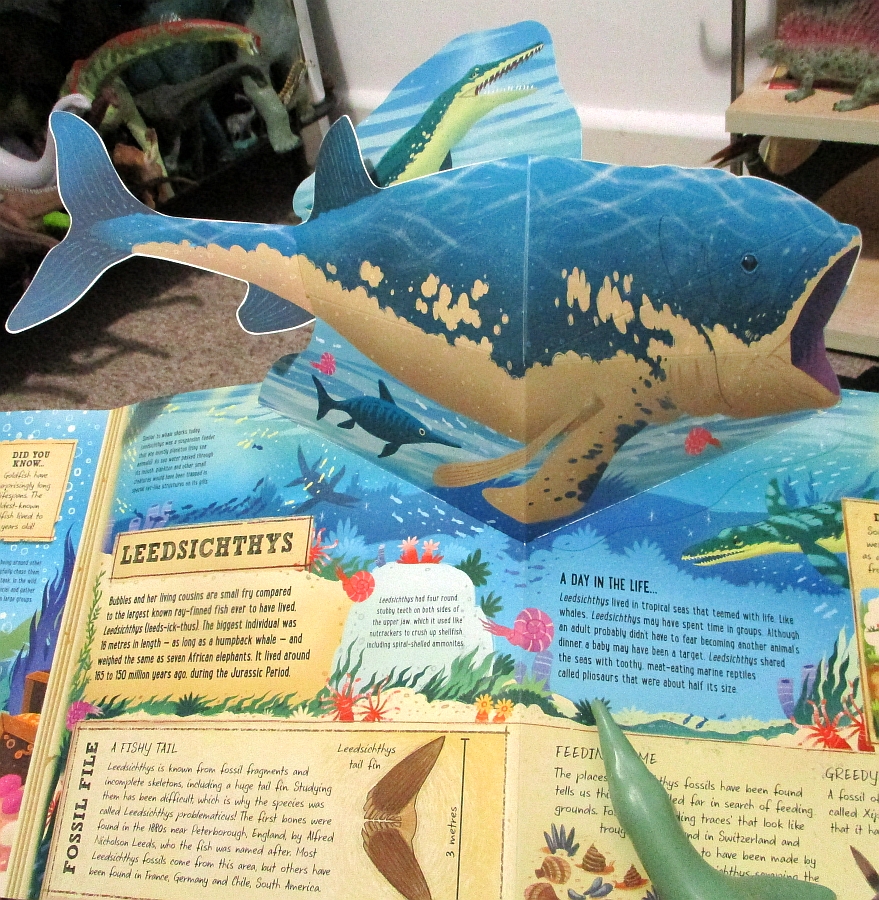Palaeontologist (and compatriot) Dean Lomax has made quite a name for himself over the last several years, and rightly so. Here’s another string for his bow – the remarkably impressive children’s book Prehistoric Pets (published by Templar), a showcase for his skills as a passionate science communicator. The cover might imply that this is simply a book about the big, angry prehistoric relatives of today’s domestic animals, but there’s so much more to it than that; this is a celebration of evolution and an introduction to the complex, diverse web of animal life and the relationships between different creatures, with our humble pets as a starting point. Plus, there are cool pop-ups. I love pop-ups.

The animals are brought to charming life by illustrator Mike Love, with design and paper engineering by Richard Ferguson. Love’s illustrations are endearingly colourful and cheerful, and while stylised, the prehistoric creatures display an admirable attention to detail. Of course, the Velociraptor is of particular interest to us, and it’s duly given a full feathery coat, complete with long remiges on the forelimbs and a tail fan. The superbly engineered pop-up reveals a semi-3D Velociraptor running through a desert environment with its arms outstretched, allowing us to take in the animal from various different angles. The pop-ups are consistently excellent, often incorporating other animals or aspects of the surrounding environment in order to immerse the reader in assorted vanished worlds.
If I were to offer one criticism of the reconstructions, it’s that too many of them have near-identical yellow eyes with slit pupils. But now I’m being picky.

Velociraptor is presented in the context of being a prehistoric relative of today’s humble budgerigar. With the budgie as a starting point, Lomax discusses avian anatomy in a suitably accessible fashion, before moving on to explore the diversity of living birds (complete with further illustrations by Love). The reader must then open up the page to reveal the pop-up dromaeosaur, along with a host of further information about Velociraptor, its relatives, and the history of their discovery. A lesser book would be content with explaining how birds are, like, totally dinosaurs, and that Velociraptor had feathers and didn’t look like it did in those movies. That Lomax also carefully explains the diversity of modern birds, how they are related to paravian dinosaurs, the anatomy and lifestyles of prehistoric animals, and how we know what we know, is highly commendable.

While Velociraptor might seem an obvious choice for a book like this, room is given over to a number of more obscure animals, many of which are likely to be introduced to young readers for the first time here. These include the enormous Jurassic fish Leedsichthys, which is given yet another fantastic pop-up that even involves a pliosaur and a cute, pop-eyed ichthyosaur, the better to flesh out the palaeoecology of the animal’s world. The inclusion of Leedsichthys (and its modern-day relative, a goldfish) means that we’re also treated to a celebration of living fish, the likes of which is (to say the least) vanishingly rare in a book like this.

Another unusual inclusion is the giant rodent Josephoartigasia, presented as the prehistoric relation of today’s guinea pig. I must admit, this animal was actually a new one for me, and I was very happy to learn all about it through Lomax’s careful, concise text. The pop-up is impressively large, making the animal appear suitably intimidating. (And people think capybaras are freakish.) Again, we are presented with an overview of rodent diversity alongside a detailed look at both Josephoartigasia and its somewhat smaller hutch-inhabiting modern relative, while a ‘Fossil File’ explains when and where the former was discovered, and how much of it is known. It’s impressively comprehensive, yet still aimed perfectly at the child reader. (As far as I can tell. I do remember being a child once.)

Finally, it’s worth mentioning that this book isn’t simply following the ‘giant savage prehistoric beast’ trope. Granted, the likes of Titanoboa were pretty giant, and likely quite savage. However, the book’s final spread is dedicated to the ‘umble ‘orse, and its even ‘umbler prehistoric precursor, Sifrhippus (formerly a species of Hyracotherium). The Sifrhippus pop-up illustration is especially gorgeous, featuring a group of animals making their way through low-lying foliage. Lomax finds room to discuss the anatomy of modern horses, their relationship with other ungulates, and even how horses have featured in cave paintings. It’s a much richer read than it might have been in the hands of a less well-qualified author.
In all, Prehistoric Pets manages to be far more than the sum of its parts. Readers are promised a pop-up book featuring prehistoric creatures, but I’m sure that any child as enthralled with the natural world as I was – and, no doubt, Lomax was – will find themselves enthralled and fascinated by this colourful and surprising celebration of animal life.







No Comments